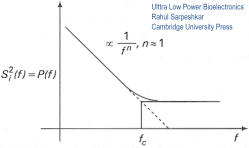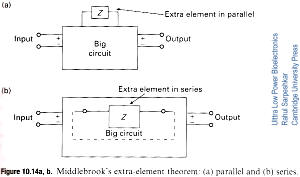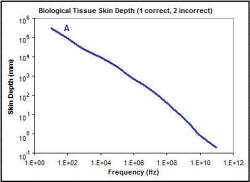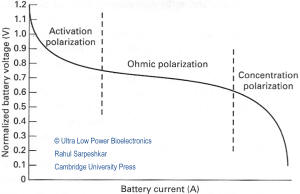Ultra Low Power Bioelectronics |
|
Click here for the complete list of RF Cafe Quizzes. Note: Some material based on books have quoted passages.
Note: Some of these books are available as prizes in the monthly RF Cafe Giveaway.
b) 1/fn Noise has many sources, including thermal. flicker, 1/f, etc. The 1/f component dominates in the region from DC to the point where 1/f noise is equal to white noise power (fc). An explanation, along with the chart to the right, is from page 170. 2. What is Return Ratio Analysis? b) A method for analyzing circuit robustness in response to changes in gain or impedance Return ratio is a quantity analogous to the robustness of a transmission feedback loop, in that its analysis quantifies the robustness of a circuit in response to a change in gain or impedance. An explanation is given in chapter 10 (p 240).
analysis of a complex system when an additional passive element is added in parallel? c) Middlebrook's extra-element theorem This approach defines how to simplify analyzing a complex system (for which a transfer function is known) when a passive element is added in parallel or in series to it. An explanation is given on page 261.
4. What function does a gyrator circuit perform? a) Inverts impedance (changes L to C, or C to L) This is an Electronics 101 circuit that uses a one or more active elements to basically switch the sign of the imaginary part of a complex impedance. An explanation is given on page 333.
5. What is a key feature of a neuron-inspired analog-to-digital converter? a) Brain-like logic b) Small size comparable to neurons c) A concept though of while using the inventor's brain's neurons d) Energy efficiency Just as the biological brain is an extremely efficient processor of information, a properly configured ADC circuit can gain enhanced efficiency. An explanation is given on page 395. 6. What does the Bode-Fano criterion state? d) For passive loads (series or parallel RC or RL), there is an inverse relationship between good impedance matching at a single frequency and good matching across the entire band This is intuitive to anyone who has struggled to find a good impedance match across a wide bandwidth using a minimum number of elements. An explanation is given on page 471. 7. Which type of biomedical implant is not likely to employ a wireless link to an external transceiver? c) Hair plug Many kinds of medical implants exploit the availability of micro-scale wireless electronics to both retrieve data from implants and to send programming data to them. An explanation is given on page 395.
skin depth in biological tissue?
b) A
Component values vary with frequency and tissue type. An explanation is given on page 526.
9. What is the approximate power consumed by the average human male brain, consisting of 22 billion neuronal cells? b) 15 W Oh, the jokes that can come from this question! It has been estimated that the human brain performs the equivalent of at least 6x1016 FLOPS (floating-point operations per second) while consuming a mere 15 W of power. An explanation is given on page 395.
a) Active, ohmic, concentration An explanation, along with the chart to the right, is from page 801. |

 1.
Which formula represents what is known as "1/f" noise?
1.
Which formula represents what is known as "1/f" noise? 3.
What is the name of the process used to simplify
3.
What is the name of the process used to simplify 8.
Which curve in the graph to the right represents
8.
Which curve in the graph to the right represents To
the left is a transmission line model of biological tissue that helps predict how an RF plane wave propagates
through tissues.
To
the left is a transmission line model of biological tissue that helps predict how an RF plane wave propagates
through tissues. 10.
Name the three regions of current-dependent battery polarization as a function of voltage
10.
Name the three regions of current-dependent battery polarization as a function of voltage